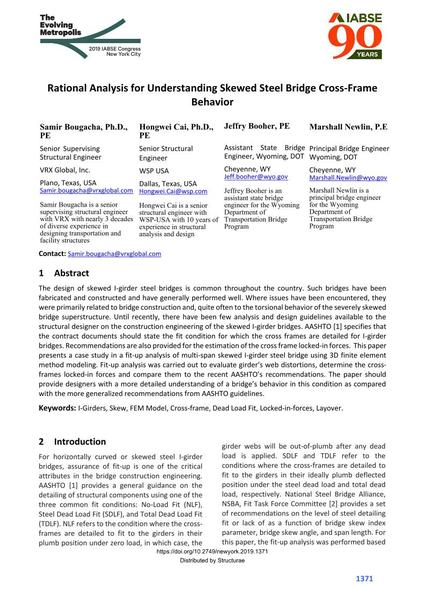Rational Analysis for Understanding Skewed Steel Bridge Cross-Frame Behavior

|
|
|||||||||||
Bibliographic Details
| Author(s): |
Samir Bougacha
(VRX Global, Inc.)
Hongwei Cai (WSP USA) Jeffry Booher (Wyoming, DOT) Marshall Newlin (Wyoming, DOT) |
||||
|---|---|---|---|---|---|
| Medium: | conference paper | ||||
| Language(s): | English | ||||
| Conference: | IABSE Congress: The Evolving Metropolis, New York, NY, USA, 4-6 September 2019 | ||||
| Published in: | The Evolving Metropolis | ||||
|
|||||
| Page(s): | 1371-1375 | ||||
| Total no. of pages: | 5 | ||||
| DOI: | 10.2749/newyork.2019.1371 | ||||
| Abstract: |
The design of skewed I-girder steel bridges is common throughout the country. Such bridges have been fabricated and constructed and have generally performed well. Where issues have been encountered, they were primarily related to bridge construction and, quite often to the torsional behavior of the severely skewed bridge superstructure. Until recently, there have been few analysis and design guidelines available to the structural designer on the construction engineering of the skewed I-girder bridges. AASHTO [1] specifies that the contract documents should state the fit condition for which the cross frames are detailed for I-girder bridges. Recommendations are also provided for the estimation of the cross frame locked-in forces. This paper presents a case study in a fit-up analysis of multi-span skewed I-girder steel bridge using 3D finite element method modeling. Fit-up analysis was carried out to evaluate girder’s web distortions, determine the cross- frames locked-in forces and compare them to the recent AASHTO’s recommendations. The paper should provide designers with a more detailed understanding of a bridge’s behavior in this condition as compared with the more generalized recommendations from AASHTO guidelines. |
||||
| Keywords: |
FEM model skew I-Girders Cross-frame Dead Load Fit Locked-in-forces Layover
|
||||
